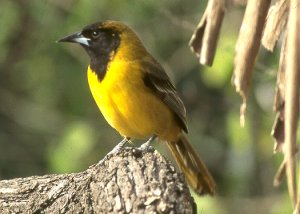
I was very pleased with the responses this month. It has been one of my pet peeves that the standard field guides are woefully inadequate in treating immature orioles, particularly the immature males. Unlike many songbirds, these orioles usually have a distinctive plumage in their first summer (second calendar year). The most thorough of our field guides, the National Geographic does not portray this plumage for either of our mystery birds.
The first is an immature male Audubon's Oriole photographed 21 February this year in Starr County, Texas. The field guides display only the adult plumage of this species. This is one of a group of non-migratory tropical species in which the sexes are similar with both resembling the bright plumage of the male. I don't think this bird can be identified via reference to any of the standard field guides. One of the best sources of accurate illustrations of these plumages is in Steve Howell and Sophie Webb's monumental "A Guide to the birds of Mexico and Northern Central America." Plate 68 illustrates an immature Audubon's Oriole of the southern race I. g. dickeyae which differs from the more northerly nominate race I. g. graduacauda in its lack of pale wing markings. Our bird clearly shows the pale wing markings of the northern race.
I would especially like to thank Al Jaramillo for sharing his knowledge of these birds including other tropical species. Al is author of a forthcoming book on New World blackbirds (Icterids) to be published in the Christopher Helm series. Perhaps that book will finally illustrate the immatures of all the orioles.
The second mystery bird is a first-year (second calendar year) male Bullock's Oriole photographed at Coyote Creek Riparian Station by Maryann Danielson. This is a commonly seen plumage in California, but failure of the field guides, especially the National Geographic to illustrate it leads to frequent misidentification of these birds as Hooded Orioles because of the yellow head and black bib. Adult Hooded Orioles have a much larger and wider bib as well as a much longer more curved bill. Howell & Web have a small illustration of this plumage of Bullock's, and the new American Bird Conservancy's "All the Birds of North America" has a fairly nice illustration of it. But that book hides the distinct pale belly of the female.
Speaking of females, older adult females may have a black bib and thus look similar to young males. I have seen many such individuals attending nests with adult males. Al Jaramillo correctly points out that this individual might actually be a female, but I have never seen one with this bright a belly. Even old females seem to me to retain the pale belly which contrasts with the yellow on the breast and undertail coverts.
The original mystery birds are below. To view public comments or add your opinion on any of these mystery birds click here.
What do you think these birds are? Please click here to view comments or add your own. Thank you very much for contributing your thoughts.